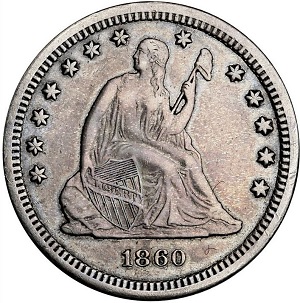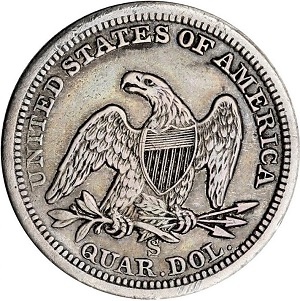1860-S Seated Liberty Quarter
The California Gold Rush attracted thousands of treasure hunters to the West Coast. In 1850, the population of the Golden State was 92,597, a number that swelled to 379,994 just ten years later.(1)
In the hustle-and-bustle of a rapidly growing region, hard currency was desperately needed to keep the wheels of commerce rolling. As the undersized San Francisco Mint(2) released coinage, it was quickly absorbed by the surrounding communities, where it circulated for many years.(3)
Like so many coins of the era, the 1860-S Seated Liberty quarter changed hands extensively. Over time, attrition took a heavy toll on the date, to the point where the coin was nearly extinct. Of the original mintage of 56,000, less than 0.5% (that’s one-half of one percent) are estimated to survive to this day.(4)
Owning an 1860-S Seated Liberty quarter is a challenging and highly desirable goal. Well-informed collectors understand why. Jim Gray, a leading expert in Seated Liberty coinage, had this to say in the November 1990 edition of The Gobrecht Journal: "the most underappreciated and undervalued of all Seated coins is the 1860-S quarter, particularly in higher grades."(5)
Since Mr. Gray made that proclamation, selling prices of the 1860-S have soared (although in higher grades, there has been a bit of a rollback since the mid-2010’s – is opportunity knocking?).
However, a review of value trends from 1950-1990 reveals price explosion is nothing new for the venerable 1860-S – a clear indicator its strong price performance is founded on solid numismatic bedrock.
One more piece of advice: Unfortunately, most 1860-S survivors are damaged, were unprofessionally cleaned, or suffered some other type of mistreatment. Attractive, original examples in problem-free condition are worth premiums in today’s market.(6) Astute collectors who recognize this will reap rewards in future years.
| Estimated survivors in all grades: 275 ?
The survivor estimate from PCGS represents an average of one or more experts' opinions as to how many examples survive of a particular coin in all grades. Survival estimates include coins that are raw, certified by PCGS, and certified by other grading services. Learn more at PCGS. |
| PCGS Rarity Scale: 6.5 ?
The 'PCGS CoinFacts Rarity Scale' assesses the relative rarity of all U.S. coins, based on estimated surviving examples. The scale runs from 1.0 to 10.0. The higher the number, the rarer the coin.
Learn more at PCGS. |
| Click HERE to check for availability on eBay** |
Preview of eBay selection:
 |
 |
| Trendline Avg = 29.04 | BETTER |
Historic Value Trend Charts:
| Last updated 4-8-25 | Return to Key Date Coin List | |
| Compare to Common Date Coin of Same Type | ||
|
|
||
| Download Charts to Your Computer | ||
Sources
1. United States Census Bureau. Bulletin 10. Population of California.
2. Bowers, Q. David. The History of United States Coinage. Los Angeles, CA: Bowers and Ruddy Galleries, Inc., 1979.
3. Heritage Auctions. 1860-S 25C. Oct 2014 Auction.
4. PCGS. 1860-S 25C (Regular Strike).
5. Heritage Auctions. 1860-S 25C. Oct 2014 Auction.
6. NGC. 1860 S 25C MS.
**Many very fine coin dealers sell on eBay. At any point in time, there may be over one million search results for United States coins. This includes quite a few of the recommendations on our Key Date Coin List.
If you’re thinking about purchasing a rare coin, eBay is certainly worth a look. For your convenience, the links from this site to eBay are coded to bring up only coins certified by PCGS and NGC.
As is always, always the case, never buy a valuable coin from a seller whose trustworthiness cannot be verified. Learn more about this at our chapter Best Places to Buy Coins, which also has a section on doing business on eBay.
In the interest of full disclosure, Rare Coins 101 receives a small commission anytime someone connects to eBay from this site and purchases something.
Coin images by Stack's Bowers Galleries.


